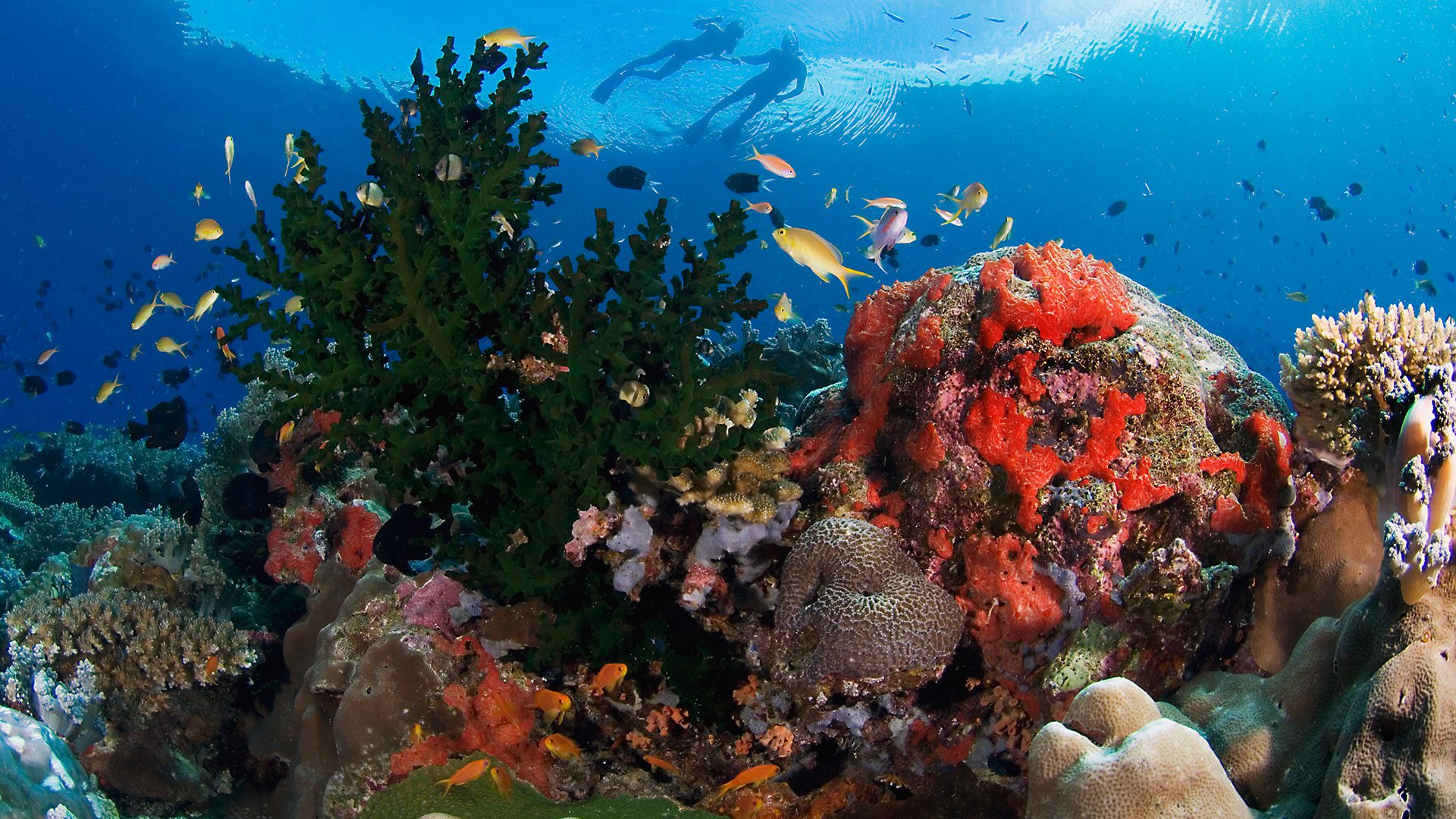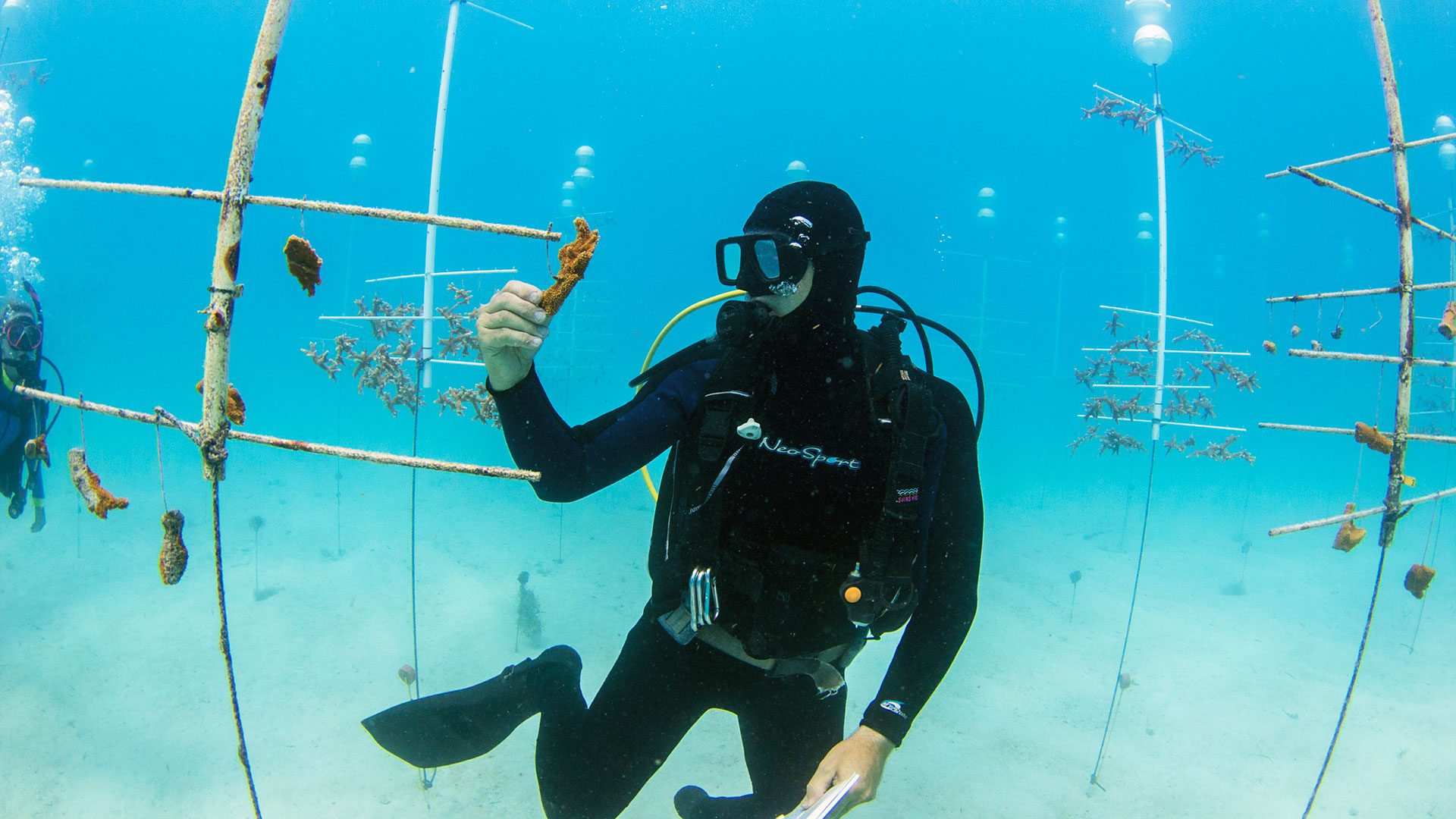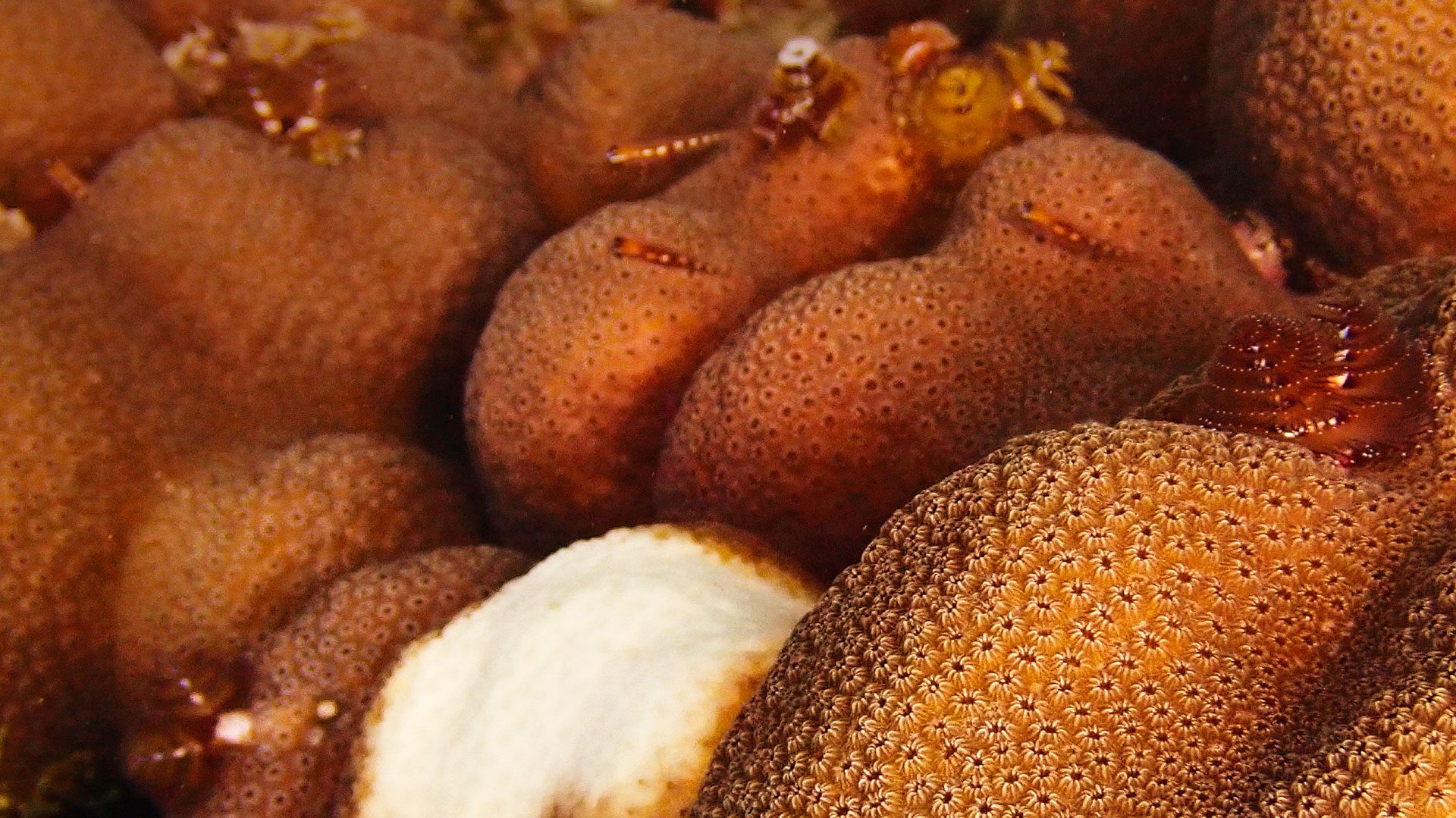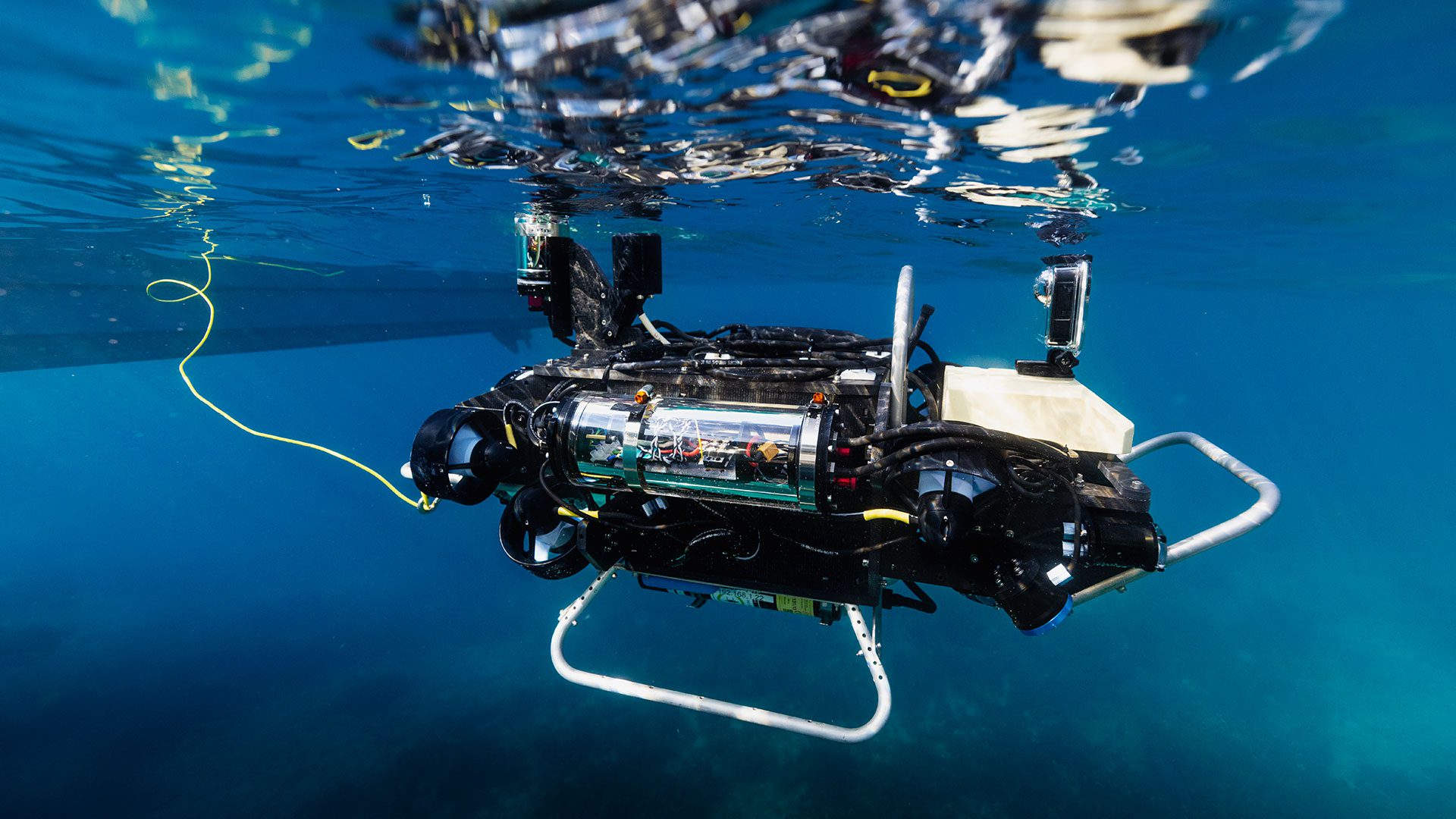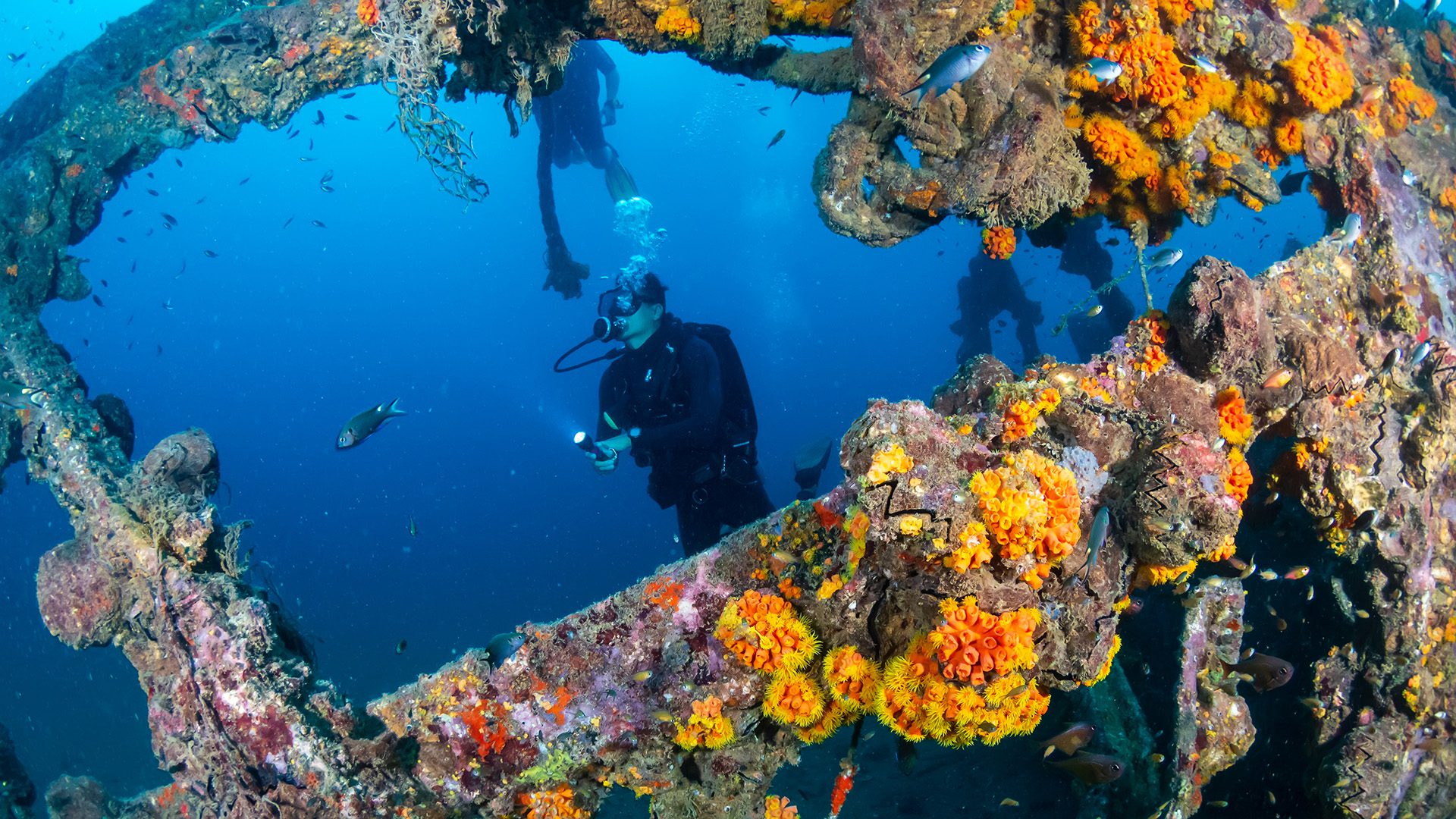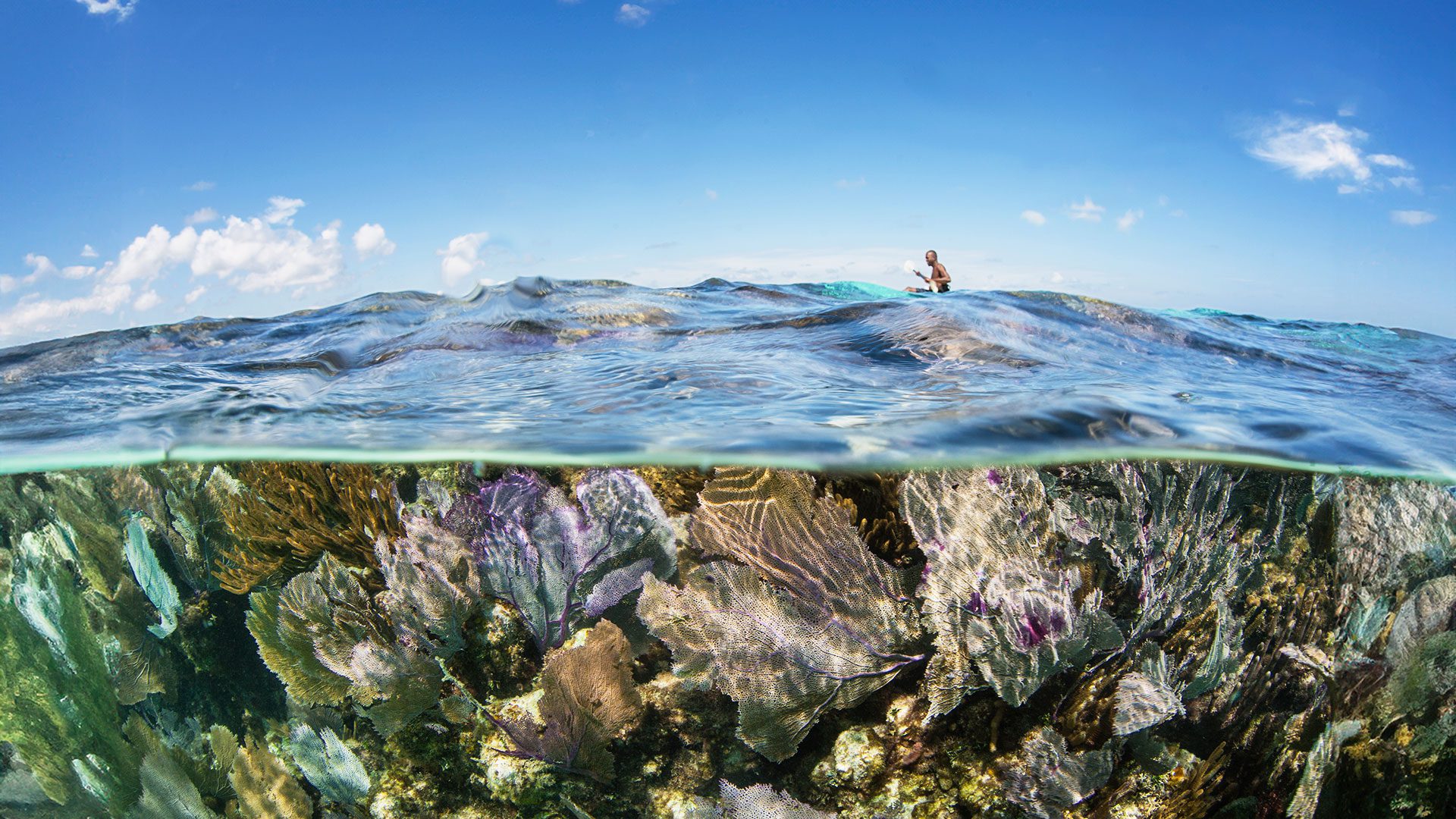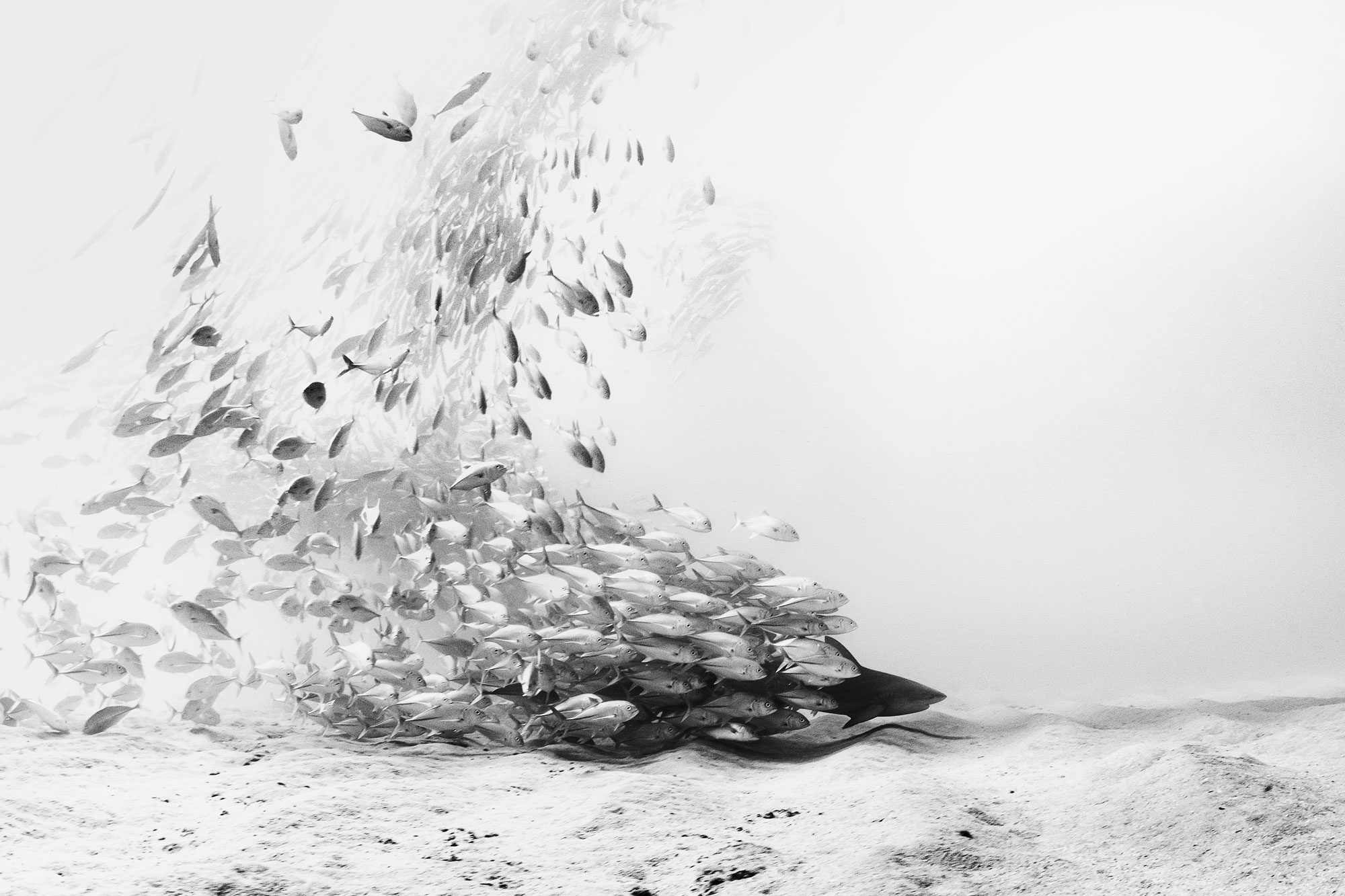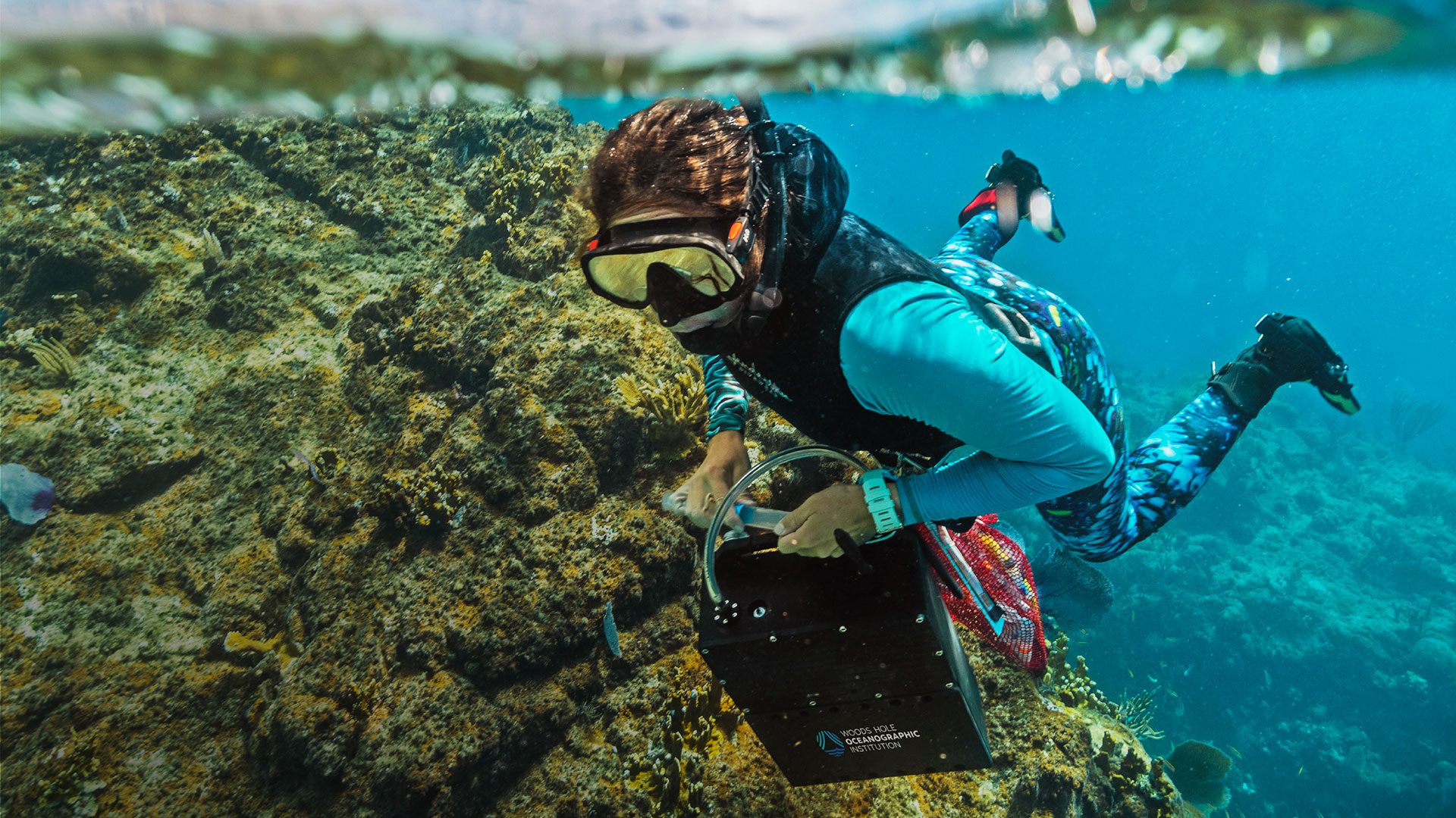
Hope for Corals in Crisis
The emerging science and technology that could give coral reefs a fighting chance
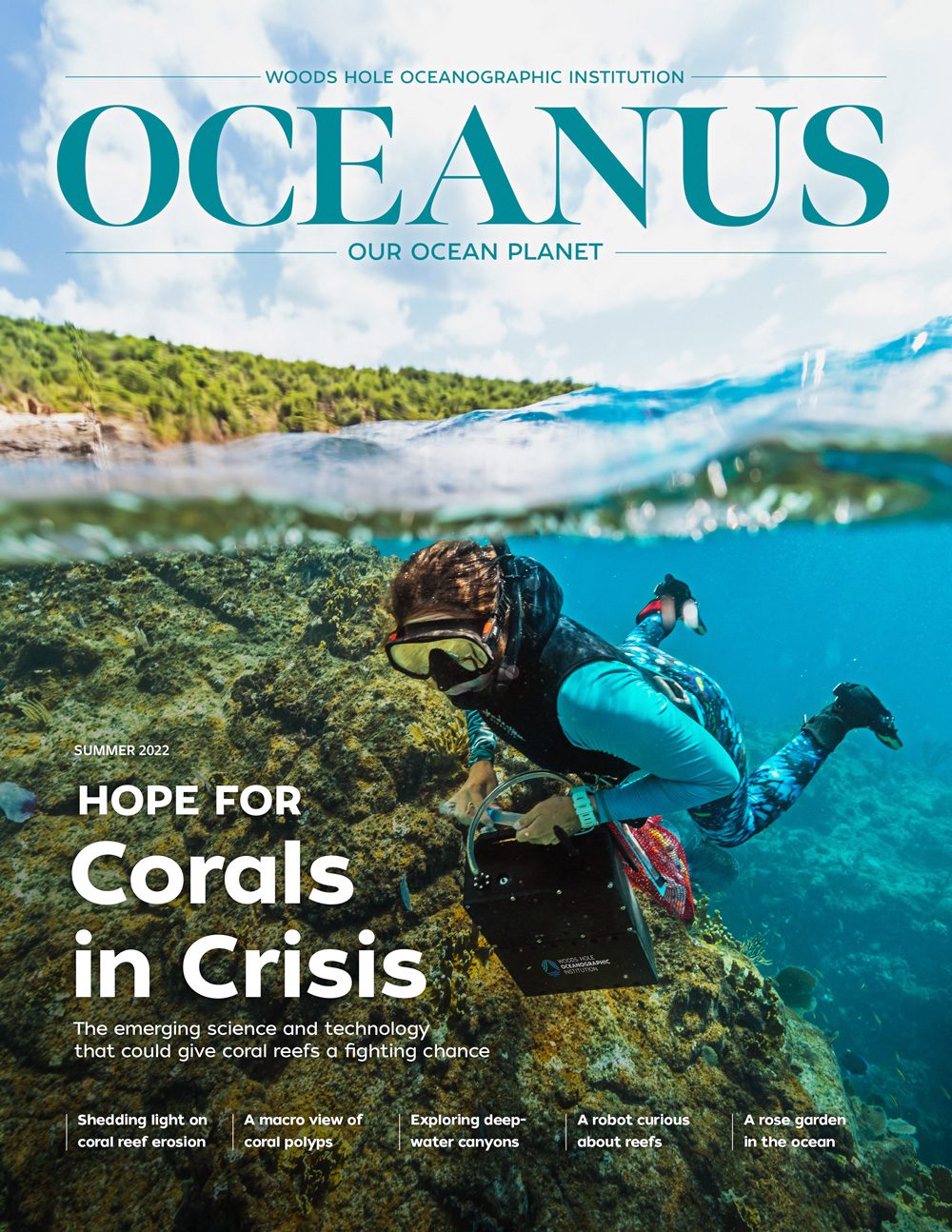 This article printed in Oceanus Summer 2022
This article printed in Oceanus Summer 2022
Estimated reading time: 16 minutes
In tropical waters across the globe, skeletal structures built by thousands of generations of coral polyps provide the foundation for some of the most diverse and valuable ecosystems on the planet.
Coral reefs teem with life. These elaborate arrangements of branching arms, mounds, tunnels, and crevices support a quarter of all marine species, despite covering less than 1% of the seafloor. Healthy reefs buffer coastlines against the damaging forces of waves and strong storms and are a vital source of food for millions of people around the world. They also generate billions of dollars each year in goods and services and have yielded an ever-increasing number of chemical compounds for use in human medicine. Whether you live on a tropical coast or have only seen corals in pictures, the value of coral reefs cannot be overstated.
Yet these vital ecosystems are in serious trouble. Researchers estimate that half of all coral reefs have been lost since the 1950s. Many more are in damaged and degraded states. Years of unsustainable fishing practices, careless tourism, coastal construction, and nutrient runoff have destroyed corals and upset delicate ecosystem balances, leaving remaining individuals vulnerable to disease and stress. And while tireless efforts of local communities and organizations have made significant progress in addressing these challenges, increasingly warm, acidic, and hypoxic waters created by climate change threaten to push the remaining corals over the brink.
But the fight to save coral reefs is not yet lost. Researchers at Woods Hole Oceanographic Institution (WHOI) are joining local communities and others around the world in bold new endeavors to address the coral reef crisis. With collaboration and investment from community organizations, industry, and governments, there is still time to protect these incredible ecosystems and the resources they provide.
Snorkelers hover over a vibrant reef of hard and soft corals, sponges, and reef fishes in Milne Bay Province, Papua New Guinea. (Photo by Jeff Yonover).
Resilient Reefs
In 2002, an unprecedented marine heatwave enveloped the tropical Pacific. For six consecutive months, sea surface temperatures in the region were almost 2° Celsius (3.6° Fahrenheit) warmer than average. The coral communities around the Phoenix Islands—an archipelago southwest of Hawaii—were devastated. About 75% of the corals died.
“But 25% of the corals survived, and we focused our research on those survivors because they were able to deal with that extreme heat,” says Anne Cohen, an associate scientist at WHOI. “Over the next several years, those corals produced enough larvae to facilitate a profound recovery.”
If the ecosystem is properly protected from other threats, corals in some areas may be equipped to handle future climate change, Cohen says. Given the opportunity, these reefs may be able to grow more heat tolerant over time.
“What we seem to be witnessing in places like the Phoenix Islands, and more recently on Majuro in the Marshall Islands, is sort of an ‘adaptation in action’ where the heat-sensitive corals are picked off and the heat-tolerant corals survive,” Cohen says. “We think there’s also potential for the larvae of two heat-tolerant parents to be even more heat-tolerant than either parent.”
Cohen refers to reefs that are more likely to survive increasing ocean temperatures as “super reefs.” Some super reefs, such as those in the Phoenix Islands, are being created as they recover from significant heatwaves. Others have been around for some time, growing in chronically hot areas where only heat-tolerant coral larvae can survive. And some super reefs are simply fortunate in their location—they are cooled by underwater currents, which protect them from heatwaves like giant air conditioners.
“What we seem to be witnessing... is sort of an ‘adaptation in action’ where the heat-sensitive corals are picked off and the heat-tolerant corals survive.”
—WHOI associate scientist Anne Cohen
Cohen is working with WHOI scientists Simon Thorrold, Weifeng (Gordon) Zhang, Nathan Mollica, and Mike Fox; researchers at Stanford University; and the Nature Conservancy’s Global Reef Program to identify these super reefs and collaborate with local authorities to establish or expand marine protected areas to preserve them. If these are the coral reefs most likely to survive climate change, Cohen wants to ensure that they aren’t destroyed by overfishing, dredging, or other threats.
The researchers use fine-scale hydrodynamic models developed at WHOI to identify where in the world super reefs are most likely to exist. Then they compare their predictions with surveys to determine if healthy corals are actually present in these areas and test the heat tolerance of coral samples in the lab. They compare that data with simulations of how the water at each reef is expected to warm over the next few decades to determine which corals are likely to survive and which reefs need to be prioritized. The researchers are also propagating and growing heat-tolerant corals from super reefs in nurseries to use in restoration efforts.
One of the locations where Cohen and her colleagues have identified heat-resistant corals is in semi-enclosed lagoons in Palau. Kirstin Meyer-Kaiser, a WHOI biologist, and Hanny Rivera, a guest investigator who earned her doctorate at WHOI, are building on Cohen’s work to investigate what makes these corals thrive.
The water in the shallow lagoons is, on average, 2° Celsius (3.6° Fahrenheit) warmer than water in the surrounding ocean. But the corals in the lagoon are flourishing, Meyer-Kaiser says. In fact, they’re doing noticeably better than corals of the same species living outside the lagoons.
“The lagoons have higher diversity, higher coral cover—they are thriving diverse communities,” Meyer-Kaiser says. “The outer reefs are doing okay—they’ve got relatively high coral cover—but they bleach more often and they’ve got lower diversity.”
The researchers are planning an experiment to determine whether the heat-tolerant corals in the lagoon could survive on the outside reefs, and vice versa. They will collect samples of coral from each reef, settle their offspring on small tiles, and replant those tiles on the opposite reef.
The two lineages of corals have some genetic mutations that differentiate them, but the researchers hope to gain a better understanding of whether it is these genetic differences or some other factor that is making the lagoon corals more resilient. In addition to investigating the coral genomes, the researchers will be examining which genes are being expressed in each group of corals and the microbial communities that live with them.
If the corals from the lagoon can survive outside, they might be able to be used to bolster the struggling exterior population. Meyer-Kaiser suspects, however, that there are other factors that could keep the lagoon corals from thriving on the outside, such as differences in light tolerance or growth rates.
“I think we’re going to find that there’s some sort of tradeoff,” Meyer-Kaiser says. “But I hope the lagoon corals can survive on the outer reefs. That would lead us down a path towards a viable strat
Mote Marine Lab scientist and program manager Erich Bartels tends to staghorn coral fragments growing from PVC pipes in an underwater nursery. (Photo by Conor Goulding, © Mote Marine Laboratory & Aquarium)..
Helping corals recover
Coral restoration efforts are already underway in many parts of the world. For the last decade, Mote Marine Laboratory in Florida has been growing corals in nurseries and replanting them on severely damaged Florida reefs.
“If you dive on a reef that no restoration has occurred on, there’s hardly any coral,” says Erinn Muller, a senior scientist at Mote who collaborates with WHOI scientists on reef research. “If you dive on a reef where we have done restoration, there’s actually living coral. And in some of the places where we’ve worked the longest, you can see how well the corals have been growing and you can see fish and other marine invertebrates clustered around the corals that we’ve outplanted. It’s a way different feel on the reef.”
Mote has about 20,000 corals growing in underwater nurseries, hanging from floating PVC trees like living Christmas ornaments. Another 30,000 corals are growing in land-based nurseries. The researchers must work carefully to maintain genetic diversity and are investigating heat- and disease-resistant strains of coral to help ensure these reefs won’t simply be wiped out again.
“We’re trying to figure out these biomarkers of resistance, whether its genetics, or gene expression, or a microbiome signature, or a particular symbiont type that we need to basically force into our corals,” Muller says. “And figure out what’s the best way to utilize that so that we’re not creating disease resistance but making the corals susceptible to some other threat.”
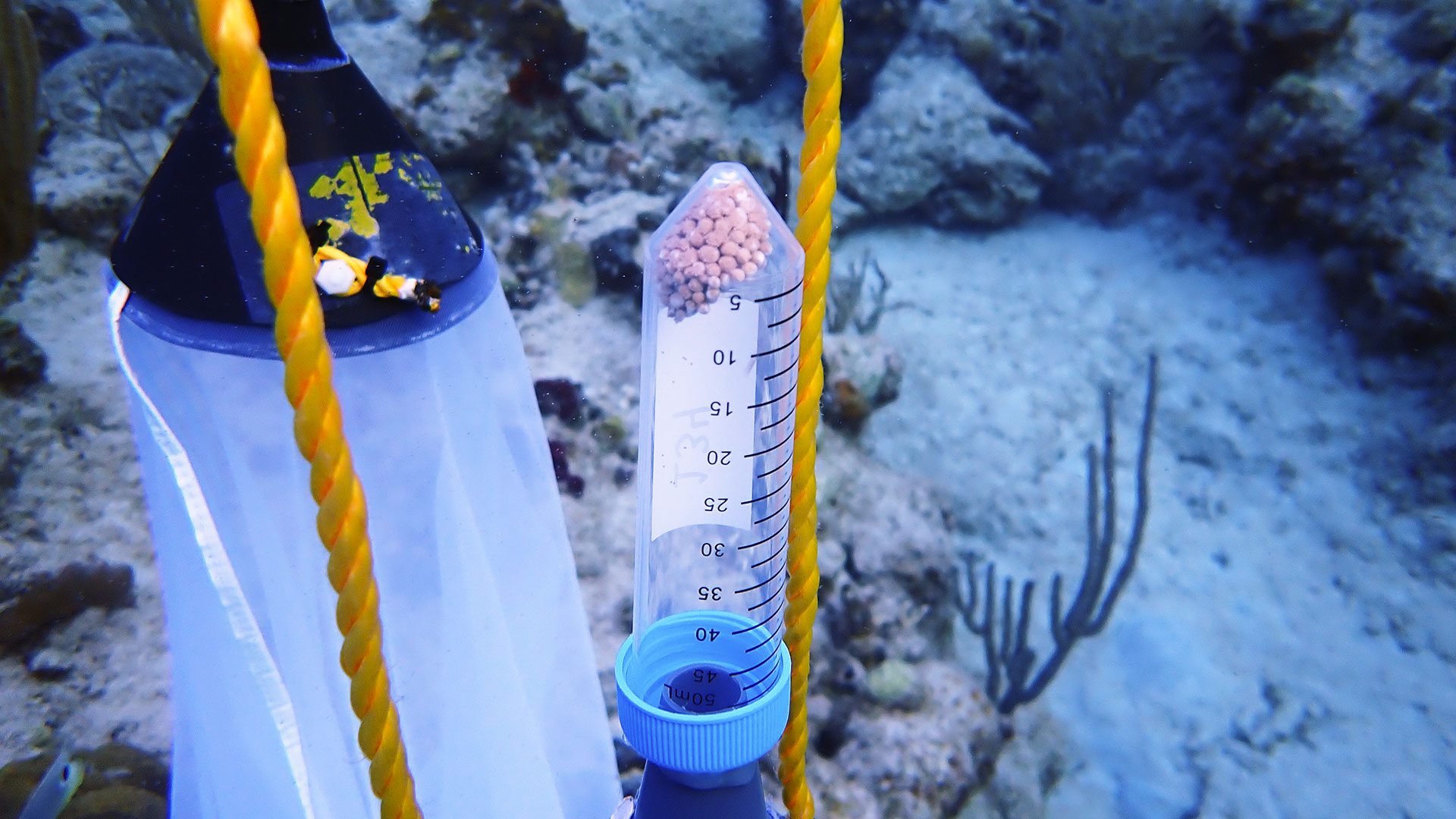
Free-swimming larval coral, called planulae, are contained while healthy reef sounds are played on an underwater speaker nearby to see if they will congregate closer to the noise. If it works, researchers think underwater sounds could be a promising restoration method for degraded reefs. (Photo courtesy of Ashlee Lillis, © Woods Hole Oceanographic Institution / Sound Ocean Science).
Over the last decade, Mote has restored over 100,000 corals to Florida’s reefs. They are seeing signs of sexual reproduction on the reefs, which will produce new generations of corals and allow them to recolonize other locations. But replanting corals is time-consuming and labor-intensive: there are only so many trained divers and they can only spend so much time in the water.
Fortunately, hand-planting corals may not be the only way to restore a reef. WHOI biologist Aran Mooney is hoping to use a simple siren song to attract coral larvae to repopulate damaged areas.
Like any ecosystem, coral reefs are awash with the sounds of various animals moving, eating, and calling to each other. But when a reef becomes degraded, it can’t support the same diversity of species. The sound of the reef changes, just as the chorus of birdsong shifts when a forest is cut down.
Most corals have a larval stage where they float freely in the water column before settling down on a reef. Mooney and his colleagues ran an experiment in the U.S. Virgin Islands to see if coral larvae use sound to determine where they want to live. They put larvae in sealed cups, isolating them from the potential influences of chemical cues in the water, and placed some cups on a healthy reef and some on a degraded reef.
In the cups on the healthy reef, more coral larvae settled on to the prepared substrate at the bottom of the cup. The sound cues indicated that this reef would be a good place to survive, and the larvae responded.
“Many times fewer larvae settle without those nice sounds,” Mooney says. “So, the next step is to record and replay the sound of a healthy reef to see if we can induce settlement.”
If coral larvae will respond to recorded sounds, it might be possible to use this technique to draw larvae into a degraded reef and encourage them to recolonize it.
“The idea is to help rebuild some of these reefs that have been lost over time—places where something in the past degraded the reef, but otherwise it is a perfectly healthy place for coral to live,” Mooney says. “Maybe we can help rebuild some of those particular areas.”
For this idea to work, especially on reefs that are too degraded to produce enough of their own larvae, there needs to be larval coral in the area that can be drawn into the reef. Weifeng (Gordon) Zhang, a physical oceanographer at WHOI, is working with Mooney to model reef currents to understand where larvae will travel.
“We need to know whether larvae will get to a reef at all,” Zhang says. “You can’t tag larvae—they’re too tiny—but we can model all this very complex, changing flow and identify the places the larvae will go.”
A large, white lesion on a colony of boulder star coral in St. Croix, U.S. Virgin Islands (Orbicella annularis) indicates the presence of stony coral tissue loss disease spreading throughout the Caribbean. (Photo by Amy Apprill, © Woods Hole Oceanographic Institution).
A new paradigm for reef research
Mooney and Zhang are part of the Reef Solutions Initiative, a recently-formed group at WHOI that is changing the standard approach to coral reef research and propelling it towards solutions. Traditionally, reef science has been led by biologists who take notes and samples while diving on reefs, but this method can only provide a snapshot in time of a reef.
“That doesn’t really capture the history of what has happened. That coral looks dead, but you don’t know why it’s dead and you don’t know when it died,” says Amy Apprill, a microbial ecologist at WHOI. “You can learn a little bit about its status, but that tells you nothing about what happened.”
Apprill and the rest of the Reef Solutions team are collaborating with scientists and engineers across a broad range of fields of research to improve on the diver-led model of reef study. They are envisioning new ways to monitor reefs, diagnose problems, and inform restoration and other intervention efforts.
“We realized that we could do more for reefs if we brought together scientists with different backgrounds and expertise; and maybe they even had a different way of thinking about a problem,” Apprill says. “We’re conducting reef science that’s more interdisciplinary and more solution-based than it has ever been.”
Much of Apprill’s own research focuses on stony coral tissue loss disease, a deadly coral disease that emerged in Florida in 2014. It has spread rapidly through many reefs in the Caribbean, wiping out huge swaths of hard corals. The disease can be treated by applying antibiotics to the lesions on corals, but divers need to catch the infection early.
While isolating a specific microbe causing a disease in the ocean is extremely difficult, Apprill and her colleagues have been able to identify a group of bacteria that seem to be associated with the disease. This is the first step towards making a diagnostic tool that could help researchers predict where outbreaks of the disease may happen.
“We envision a sensor mounted on a robot that can swim around and detect these pathogens. This could provide an early warning system for disease,” Apprill says. “That would at least allow people that can administer these treatments to get ahead of it and be ready for it.”
“We’re conducting reef science that’s more interdisciplinary and more solution-based than it
has ever been.”—WHOI microbial ecologist Amy Apprill
Ideally, this would be just one in a suite of diagnostic tools that could be deployed on reefs. Members of the Reef Solutions team are working on ways to monitor the
sights, sounds, chemicals, and microbes on reefs to create a constantly updating picture of reef health. They hope to be able to catch problems as they occur, instead of spotting the evidence when it’s already too late.
To obtain frequent, consistent measurements, the team is looking towards autonomous systems instead of relying exclusively on divers. Yogesh Girdhar, a roboticist at WHOI, has programmed a “curious robot” that can notice and focus on what is new or unusual in a reef environment. This robot, or perhaps a fleet of them, could serve as inexpensive platforms for monitoring reefs.
“We have been looking at ways to make a swarm of robots have a synchronized, machine-learning-based understanding of the ecosystem they are in, so we can focus data collection efforts on what is ecologically important,” Girdhar says. “I would love for them to be deployed all over the world, continuously observing coral reefs at all these different scales, as an early warning system for reef health.”
Putting reef science into the right hands
Ultimately, many of the decisions about how to protect and restore coral reefs will be made by the communities and governments that live alongside them. It is up to researchers to ensure that decision-makers have the best information possible on hand when they make choices.
“WHOI scientists are ambassadors—not only for WHOI, but for science,” Cohen says. “When we go to places like Palau, or Tuvalu, or the Marshall Islands, we work very closely with the people on the ground. We’re working with conservation organizations; we’re working with students; we’re working with teachers; we’re talking to governments. It’s a really important part of our job.”
Cohen and her colleagues have embarked on a project to facilitate information sharing by building a “digital twin” of a coral reef. Some of the intricacies of how a reef works can be difficult to envision, but with this project, anyone will be able to dive into a visualization of a real reef on their computer or smartphone and see the currents and temperatures move over time, almost like a map in a weather app. The three-dimensional simulation will allow people to visualize an entire reef system, access scientific data, and predict how actions taken now might impact a reef in the future.
“We are producing this incredible information, but it’s not getting to people in a form that they can use,” Cohen says. “We need to deliver very complicated data and information in a way that can be used to make the most effective decisions for risk management; to figure out where to put marine protected areas that won’t die in the next heatwave; and for fishermen to decide what the currents are doing today so they’re not wasting fuel or catching the wrong kind of fish.”
The Digital Twin team, which includes collaborators in the Marshall Islands and Guam, as well as at Siemens Technology Corporation, the Nature Conservancy, and the National Ocean and Atmospheric Administration, is currently building a prototype based on the reef at Palmyra, an atoll in the central Pacific. The digital replica will combine Zhang’s hydrodynamic models of shifting currents, temperature, and salinity with 3D imagery of the corals themselves. When it is complete, users will be able to dive into the virtual reef and look around, track shifting conditions in three dimensions, follow the trajectories of larval fish and corals, run future simulations, and conduct ‘what-if’ scenarios. Once they have a working framework, the team intends to build a publicly accessible network of digital twins for reefs across the global tropics.
“Science has so much to offer in this time of unprecedented change, but we can’t march into countries and tell them what to do,” Cohen says. “But we can put the power of information into the hands of people who rely on those reefs, who are managing them and making the conservation decisions.”
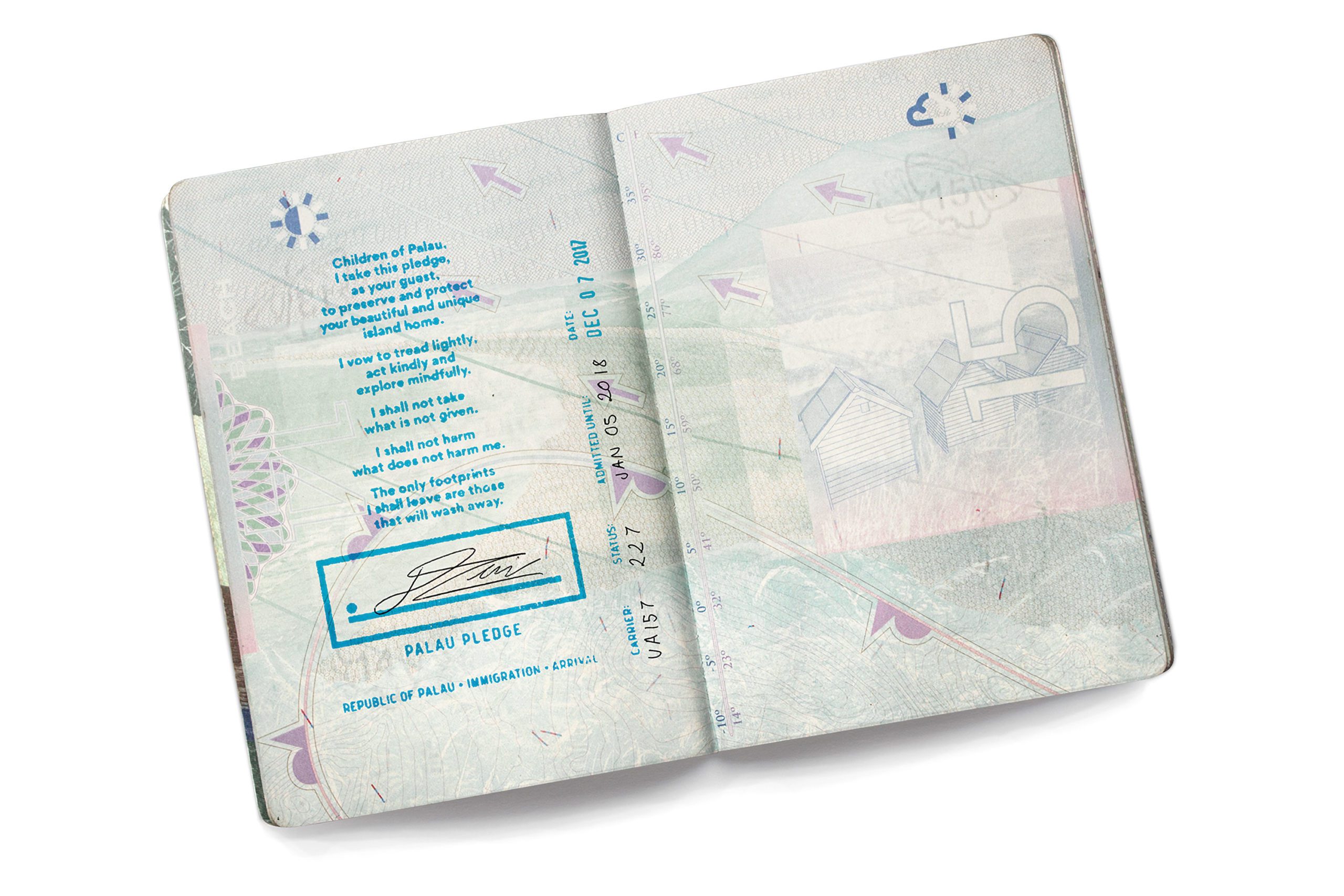
On a passport, the "Palau Pledge" challenges visitors to protect the island's fragile ecosystems for generations to come. (Courtesy of palaupledge.com).
A coral-friendly future
The Palau stamp takes up an entire page of Kirstin Meyer-Kaiser’s passport.
“It’s a poem, a vow to protect the environment,” Meyer-Kaiser says. “You have to sign it in front of one of their customs officers.”
The passport pledge was introduced in 2018 as part of a campaign to encourage more responsible tourism and protect Palau’s natural resources—including its reefs—for future generations. These efforts are supported by numerous environmental laws and a marine protected area that, as of 2020, covers 80% of the country’s ocean. And so far, they have worked.
“When I go to Palau I’m just in awe of the healthy coral reefs, this giant marine protected area,” Meyer-Kaiser says. “They have something really unique.”
But the burden of protecting and restoring coral reefs belongs to everyone, not just the people who live closest to them. These ecosystems provide global benefits and are a vital part of our oceans. In addition to the direct actions of scientists, industry, and governments to maintain healthy reefs, it’s going to take a concerted global effort to cut carbon emissions and give reefs the opportunity to adapt to the effects of climate change.
It’s a daunting challenge, but not an impossible one.
“We just haven’t given reefs a chance yet,” Apprill says. “Big problems like the coral reef crisis require large intervention teams and big money. We’re bringing groups together that can advance the science and technology and move it into the applied realm faster than has ever been done for reefs.”
What's causing the coral crisis
Healthy corals support healthy marine ecosystems, but corals are in crisis on many fronts. High levels of carbon dioxide are warming ocean waters and causing them to become more acidic. Pollution and overfishing put pressure on reef populations. Large algal blooms deprive shallow waters of oxygen, which harms stationary animals, such as corals, and strong tropical storms can physically damage reefs.

Stages of Deterioration
Healthy Coral
Coral polyps live in small openings on the surface of their hard skeleton. They nab bits of food from the water, but most of their energy comes from colorful algae living in their tissues. The algae use photosynthesis to feed both themselves and the corals in a symbiotic relationship that supports the reef, as a whole.
Bleaching
When corals become stressed by warm temperatures or pollution, their algae struggle to photosynthesize. They begin to produce harmful molecules, and the corals eject the algae to protect themselves. Without their colorful symbionts, the white skeleton shines through the coral’s clear tissues, turning them a ghostly white.
Algae sets in
If conditions improve, corals can regain their algae and thrive once again. But in many cases, corals remain bleached, and the polyps eventually starve. Dead coral provides places where macroalgae can take hold along the reef. Fast-growing algae can take over large areas in just a few months’ time, out-competing coral larvae attempting to recolonize the reef. When coral larvae do settle, they may fail to grow if the algae shade them from sunlight.
Diseased Coral
Corals become particularly susceptible to disease under stressed conditions, and some macroalgae transmit pathogens to corals when they move in. Stressed corals struggle to repair damaged tissues and become unable to compete with encroaching algae. Heat stress, in particular, makes corals susceptible to disease, and infected corals may continue to die off, even after temperatures have returned to normal. Because corals are continually exposed to a variety of stressors, large swaths of coral reefs are at risk.
What's causing the coral crisis
Healthy corals support healthy marine ecosystems, but corals are in crisis on many fronts. High levels of carbon dioxide are warming ocean waters and causing them to become more acidic. Pollution and overfishing put pressure on reef populations. Large algal blooms deprive shallow waters of oxygen, which harms stationary animals, such as corals, and strong tropical storms can physically damage reefs.

Stages of Deterioration
Healthy Coral
Coral polyps live in small openings on the surface of their hard skeleton. They nab bits of food from the water, but most of their energy comes from colorful algae living in their tissues. The algae use photosynthesis to feed both themselves and the corals in a symbiotic relationship that supports the reef, as a whole.
Bleaching
When corals become stressed by warm temperatures or pollution, their algae struggle to photosynthesize. They begin to produce harmful molecules, and the corals eject the algae to protect themselves. Without their colorful symbionts, the white skeleton shines through the coral’s clear tissues, turning them a ghostly white.
Algae sets in
If conditions improve, corals can regain their algae and thrive once again. But in many cases, corals remain bleached, and the polyps eventually starve. Dead coral provides places where macroalgae can take hold along the reef. Fast-growing algae can take over large areas in just a few months’ time, out-competing coral larvae attempting to recolonize the reef. When coral larvae do settle, they may fail to grow if the algae shade them from sunlight.
Diseased Coral
Corals become particularly susceptible to disease under stressed conditions, and some macroalgae transmit pathogens to corals when they move in. Stressed corals struggle to repair damaged tissues and become unable to compete with encroaching algae. Heat stress, in particular, makes corals susceptible to disease, and infected corals may continue to die off, even after temperatures have returned to normal. Because corals are continually exposed to a variety of stressors, large swaths of coral reefs are at risk.

